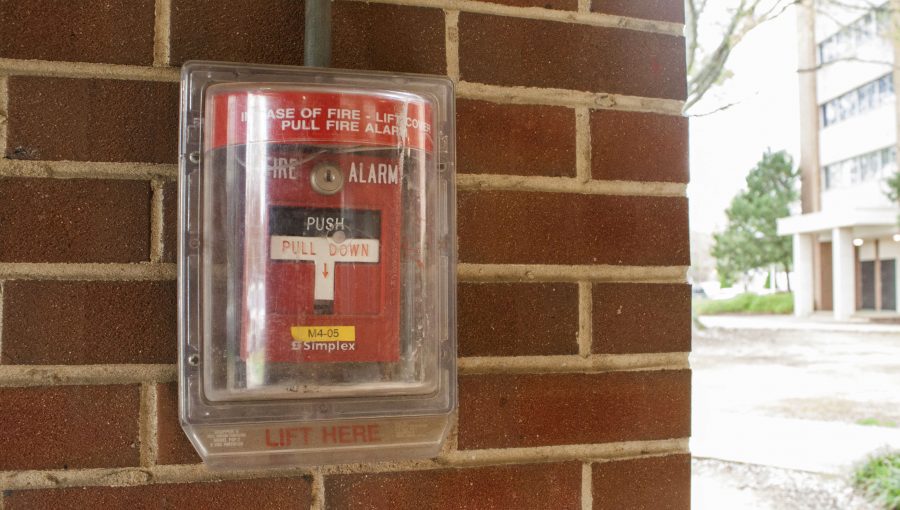According to Alan Martin, Fire Chief of Tuscaloosa Fire & Rescue Service, one of the most important things to do if there is a fire is to exit the building as soon as possible.
“In the event of a fire, you need to get out and stay out,” Martin said.
Students should always have an exit route for emergencies in mind, but should they find themselves caught in a fire, there are several things they should do. According to Housing and Residential Communities’ (HRC) fire safety tips, students should stay low to the ground to avoid asphyxiation, cover their nose and mouth with a damp cloth if possible, and open the door and exit, so long as the door is not hot. If it is hot, students will need to find another way to exit.
The University’s Office of Environmental Health and Safety releases fire safety information as well. They recommend using the buddy system, especially for students with disabilities. Students with disabilities should plan and discuss with a buddy what help they will need in the event of an emergency. According to EHS’s guide, students in wheelchairs should be brought to areas of rescue assistance, such as stairwell landings.
Once out of the building, Martin said students should not go back in for other people, though they should try and make sure everyone knows there is danger.
“If there’s someone else in the home, you need to make sure they know there’s a fire, but you don’t go back in … once you’re out you want to stay out,” Martin said.
A student’s next step, once safely outside of the building, should be to call 9-1-1. If a student’s buddy is in the building, emergency workers should be notified of their location as soon as possible.
If a smoke alarm goes off in a University of Alabama building, The University of Alabama Police Department (UAPD) will be notified immediately, but it doesn’t hurt to call them – after making the initial call to 9-1-1 – as well.
“[If there is a fire] you would assume we would know about it, but we wouldn’t want that to discourage you from calling,” said UAPD Officer Ron Prewitt, UAPD.
Prewitt explained that calling 9-1-1 connects students to a dispatcher, who then contacts the right agency, but that by calling 205-348-5454, students will be sent directly to the UAPD line.
“That is the best way to get a hold of us,” Prewitt said. “It equates to a much faster response time.”
Once on the scene, UAPD can give the fire department updates, secure the area and control traffic. Officers may have to issue student non-academic misconducts (SNAMs) while at the scene of a fire as well.
The University has its own police department, but not its own fire department. This is in part because of the close proximity of the Tuscaloosa Fire & Rescue Service fire station 2 on Paul Bryant Drive.
“There is no University of Alabama fire department, but [a fire department] is right there,” Prewitt said.
In order to lessen the chance of needing fire station 2 and other members of the Tuscaloosa Fire & Rescue Service, Martin recommends students reduce the number of fire hazards in their living area.
First and foremost, Martin said students who are cooking something on the stove need to stay in the kitchen.
“The leading cause of fires in apartments are cooking fires,” Martin said.
If a fire does start while a student is cooking, Martin said students can turn off the stove and try sliding a lid across the fire without burning themselves. That is the only time Martin recommends trying to fight the fire yourself.
“Anything other than that, anything bigger than that as far as fire and size of fire, you need to get out of the [building], call 9-1-1, and stay out,” Martin said.
Students should also have at least one working smoke alarm and check it monthly by pressing its button. Martin said the best kinds of smoke alarms are those that are hardwired into the wiring of the home, or one with a ten-year silk lithium battery. He recommends having a carbon monoxide detector and a fire extinguisher as well, though with the latter he again said that students should not spend a lot of time trying to fight the fire themselves.
Martin also noted that smokers need to discard of all materials properly and that students using a portable space heater should have one with tip over protection, should not use an extension cord with it, and should keep it at least three feet from combustibles.
Martin discourages students from using candles as well, as open flames are dangerous anytime they’re being used. Students should use battery-operated candles instead.
“Nowadays the battery-operated candles can come scented and flicker,” Martin said. “If what you’re looking for is the ambiance, you can get that with the battery-operated ones. You don’t have to have the real thing.”
EHS is the body on campus that works to keep the university safe from fire hazards. One of its many roles is making sure buildings are equipped with the proper fire safety equipment and that that equipment is properly maintained.
According to EHS’s website, equipment varies from building to building and can include “fire alarm systems, special hazard suppression systems, sprinkler systems, kitchen hood suppression systems, fire extinguishers and other building equipment such as exit lights and emergency lights.”
Variations in what equipment is available is a reflection of the potential hazards present in a certain building.
Kimberly Sterritt, associate director of housing administration, said that EHS works especially closely with HRC. All dorms also have a fire extinguisher on every floor and a smoke detector in every room.
“There is also, on the back of every single door – provided the student does not remove it – fire instructions and evacuation instructions,” Sterritt said.
Sterritt added that EHS trains resident advisors and other HRC staff on fire safety protocol as well.
EHS also keeps fire reports as part of The Clery Act, showing that there were two on-campus housing fires in 2015, down from nine in 2009. These reports are available to the public.
To view these reports and for more information on fire safety and statistics at the university visit: http://ehs.ua.edu/operations/fire-safety/ and http://housing.ua.edu/off_campus/fire_safety.cfm.
In the event of a fire, emergency call 9-1-1 to be directed to the Tuscaloosa Fire & Rescue Service, followed by 205-348-5454 to get in contact with UAPD.







